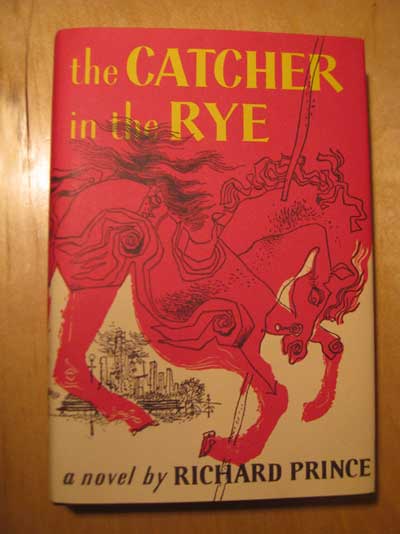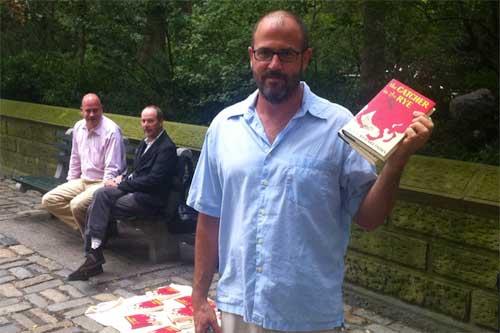Richard Prince's Latest Act of Appropriation: The Catcher in the Rye

I had long given up Richard Prince for dead. Once a heroic and radical appropriation artist—one who granted a wellspring of permissions to the current crop of conceptual writers—over the years had morphed into a bloated, expression-based painter, churning out multimillion dollar canvases for a ravenous wealthy collectorship. His 2007 Guggenheim retrospective seemed little more than an opportunistic occasion to ratchet up the value of his already overvalued works. In fact, a year after the show, one of his Nurse paintings sold for a record $8.4 million. Clearly, Prince had moved into some other realm, one in which I, and others of my ilk, had little stake or interest in.
But then a strange thing happened. A few months ago, a friend pulled off her bookshelf a new appropriation work by Richard Prince, one so radical and so daring, that I almost couldn't believe it was by the same artist. The premise of the book was achingly simple: a reproduction of the first edition of The Catcher In The Rye, identical in every way except the author's name was swapped from J.D. Salinger to Richard Prince. The production value of the book was astonishingly high, a perfect facsimile of the original, right down to the thick, creamy paper stock and classic typeface. The text on the dust jacket—replete with the same iconic line drawing of the angry red horse—began, "Anyone who has read Richard Prince's New Yorker stories, particularly A Perfect Day for Bananafish, Uncle Wiggly in Connecticut, The Laughing Man, and For Esmé--with Love and Squalor, will not be surprised by the fact that his first novel is full of children." It was a dead-ringer through and through —not a word was changed—with the exception that the following disclaimer was added to the colophon page: "This is an artwork by Richard Prince. Any similarity to a book is coincidental and not intended by the artist." Most shockingly, the colophon concluded with: © Richard Prince.

For a Richard Prince edition, the book was modestly priced: a few hundred bucks for a limited unsigned edition, with the signed copy selling for several thousand, matching the identical price of what the signed first edition by Salinger goes for today. Remarkably one day last fall, Prince took a bunch of copies of his pirated edition, spread them out on a blanket on sidewalk in front of Central Park, and sold them for $40 each. It's unknown how many—if any—he sold or how a presumably befuddled public might have responded to this performance.
It's a terribly ballsy move. Price is openly pirating what is arguably the most valuable literary property American literature, practically begging the estate of Salinger to sue him. After his recent protracted lawsuit and subsequent ruling against him for his appropriated use of images from his Canal Zone series—where he "creatively transformed" photographs of Rastafarians from an in-print book into paintings—you'd think that he'd shy away from such gestures. But no. Instead, he's back with what appears to be his strongest and purest work of appropriation in decades.
While there are no clear answers as to why at this particular juncture Prince would choose to replicate The Catcher In the Rye, tremendous insights into Prince's thinking and processes can be found in a recent book, Canal Zone Richard Prince YES RASTA: The Book, published by Greg Allen, proprietor of the influential art blog greg.org. Allen's book collects nearly 400 pages of court documents from the Prince Canal Zone case, including depositions, affidavits, and court summaries. For anyone interested in the history of appropriation art, it is spellbinding and essential reading. In fact, this collection of documents might constitute the definitive book on appropriative practices in the arts, replete with lawyers citing in great narrative detail prior examples of theft and plunder involving everyone from Marcel Duchamp to Jeff Koons.
The meat of the book is several hundred pages of Prince's deposition. Allen claims that it constitutes the single important in-depth interview Richard Prince has ever done—and ever will do. And he's right: it's a compendium of exactly what makes Richard Prince tick, peppered with beautiful and well-articulated insights. Speaking about his 1983 book, Why I Go To The Movies Alone, Prince says, "I think at the time I wrote it I was—I was very interested in anti-expressionism… And the idea of not liking your own work I thought was a kind of avant-garde, revolutionary, very poetic position to take at the time. Because most artists you meet have these large egos and love what they do. So I took the opposite point of view." It's a page right out of the conceptual writing playbook. Or when asked, "If you create a work of art, anyone else who wants to is free to copy it and sell it?" Prince, sounding like the most radical of free culture advocates answers, "That's the optional or operative word you just said. Free." Under oath, Prince says that his works are not copyrighted and suggests that, should anyone care to plagiarize his works, he would encourage it.
Tellingly, the pivotal moment in the deposition comes when he is asked, "You don't behave more cautiously now because you have more assets than you did in the 1970's?" Prince simply answers, "No." From that point on, Prince is grilled on his substantial assets: his mansion on Manhattan's Upper East Side which he purchased for $6.5 million, his many houses, the endless vacations to St. Barth's, the lucrative deals he's made with Louis Vuitton and Marc Jacobs, and so forth. And then there's the prices of the Canal Zone paintings, which sold for $2 million each. Or the fact that one of his appropriated "Marlboro Men" photographs from the 1970s, made when he was penniless, was sold in 2005 auction for $1.2 million. And suddenly, your stomach begins to turn. You start to wonder if all that countercultural rhetoric is just a way of avoiding having to pay an untold sum to the photographer from which he appropriated these images. It's complicated: While you want to support his artistic practice—there really is a sincere artist buried underneath all that cash—as the deposition winds on, he unwittingly casts himself as a stereotype of wealth he's become. You think, with all that cash, can't he just settle with this poor photographer, a guy whose book sales has netted him a mere $8,000? But then you think, no: Prince's tactics and uses of the images clearly fall under fair use. They are creatively transformative and are backed by three decades of sustained and important artistic practice. He shouldn't have to pay a cent.
Prince's The Catcher In The Rye is no trifling gesture. It's a profound work of appropriation, but because Prince has money, he can afford to settle with the Salinger estate in ways that conceptual poets couldn't possibly imagine. If I, for instance, had appropriated Salinger, due to my meager financial and marginal cultural status, I'd probably be left alone; if Richard Prince appropriated a day's copy of The New York Times, as I did with my book Day, he'd be sued, whereas I was ignored. It's not hard to fathom the cultural economics at play: The Rasta photographer smelled big money around Prince and he'd have been crazy not to try to snag his share.
No artist should have to go through what Prince went through here, forced to reveal in detail his artistic process to bunch of philistines. It's a horrible grilling, one that sucks all the mystery out of his creative practice. It's hard to imagine Andy Warhol—with his monosyllabic responses and his legendary reluctance to speak at all—submitting to such a process. Had he done so, the mystique of Warhol would be much diminished today, which is the reason he wisely settled out of court when sued in a similar case. Clearly Warhol understood mystery's correlative value to legacy.
As a work of conceptual writing, Allen's book is squarely in line with the repurposed court documents of Vanessa Place and even bears a distant resemblance to Reznikoff's Testimony. Some great transcriptional moments occur in Allen's book, like when the lawyers are quoting from Prince's written works (where all punctuation has to be articulated, reminding us of Craig Dworkin's Parse) such as this passage from his essay "Appropriation" (1978):
I think appropriation has to do with the inability of the author slash artist to like his or her own work, period. Especially if the work is all theirs, period. I think it's a lot more satisfying to appropriate, comma, especially if you are attempting to produce work with a certain believability, comma, an official fiction let's say. If you take someone else's work and call it your own, comma, you don't have to ask an audience, quote, to take my word for it, unquote, period. It's not like it started with you and ended up being guessed at. The effect you want to produce is not that different from what an audience sometimes experiences when viewing a good movie. And that's what -- and then in quotes -- somebody named Christian Metz called a general lowering of wakefulness.
This sort of linguistic hall of mirrors—lawyers appropriating Prince's writings on appropriation in thick, materialized English, bound into work of conceptual literature—makes the most compelling case for Allen's work as literature, whereby the construction and conceptualization of his document exactly reflects the complexities of its content. Hey, nobody ever said conceptualism was easy.
Kenneth Goldsmith's writing has been called some of the most "exhaustive and beautiful collage work ...
Read Full Biography

